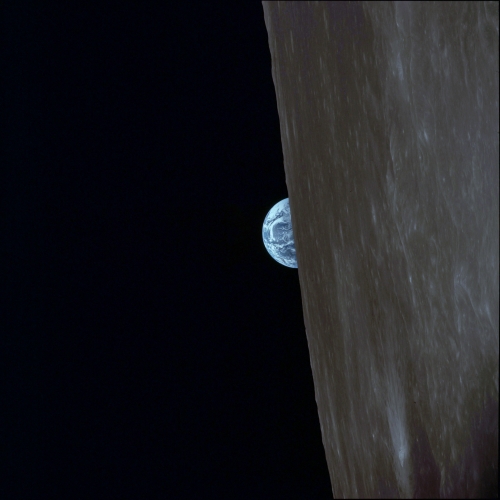Centauri Dreams
Imagining and Planning Interstellar Exploration
Can Social Insects Have a Civilization?
I first encountered Michael Chorost in his fine book World Wide Mind (Free Press, 2011), which looks at the relationship between biology and the machine tools that can enhance it. Mike’s thinking on SETI has already produced rich discussion in these pages (see, for example, SETI: Contact and Enigma). In today’s essay, he’s asking for reader reactions to the provocative ideas on insect memory and intelligence that will inform his next book. While it does not happen on Earth, can evolution invent — somewhere — a social insect society capable of long-term memory and civilization? A nearby planet evidently hostile to our kind of life offers fertile ground for speculation.
by Michael Chorost

I’ve admired Paul Gilster’s Centauri Dreams for many months and I’ve always been impressed by the quality of the comments. Paul graciously allowed me to write a guest entry to test one of my book-in-progress’s ideas on a smart audience — you.
This book-in-progress will be my third book. My first two books were about bionics and neuroengineering, respectively titled Rebuilt (Houghton Mifflin, 2005) and World Wide Mind (Free Press, 2011.) I’ve also published in Wired, New Scientist, Slate, Technology Review, the Chronicle of Higher Education, and Astronomy Now.
The book is about communication with extraterrestrials. Not by radio but in person, with us visiting their planet and looking at their mugs (or whatever they have instead of mugs). How should we begin trying to communicate? What could we safely assume — and not assume — about how minds think? What knowledge could we bring to bear from evolutionary theory, linguistics, cognitive science, and computer science?
Of course, direct contact anytime soon is unlikely in the extreme. That’s why, below the surface, the book is about a deeper set of issues: What are the universals of thought and language? Can intelligent minds be so different as to render communication impossible? What kinds of advanced cognition can an evolutionary process invent? The book gets at these ideas by using alien communication as a vehicle.
So here’s the idea I want to test on you all. I asked myself, “Would it be possible for social insect colonies on some other planet to evolve to have language and technology – in other words, a civilization?”
Of course, the idea of swarm intelligence, or hive-mind intelligence, has been around forever in science fiction. To give but one example, Frank Schatzing’s The Swarm posits an undersea alien made of single-celled, physically unconnected organisms that collectively have considerable intelligence. But I need to examine the idea with much more rigor than can be done in fiction.
I refined the question by deciding that, as on earth, the individual insects would have brains too small for serious cognition. The unit of analysis would not be individual bugs but colonies of bugs. The intelligence would have to emerge from their interaction.
After much thought, my answer to the question is “No – but…”
Let me explain both the No and the but. It is these explanations on which I want your feedback.
To start with the No. I don’t think it’s possible for physically separate units to form a collective that supports high intelligence. The reason is straightforward: physically disconnected units have no way of permanently storing large amounts of discrete information in a way that is available to the collective. More succinctly, they can’t support long-term memory.
Of course, information can be manipulated by collectives even when the units have no permanent connections among them. If you’ve read Douglas Hofstadter’s “Ant Fugue” you know how ant colonies collectively find and consume food. A forager comes across food and lays a pheromone trail while returning to the nest. Other workers follow that trail and lay down pheromones of their own. When the food is gone the returning ants stop emitting pheromones, and the ants move on to other things. From a global perspective it looks as if the colony has a “memory” of the food source. Insect colonies have many mechanisms of this sort, which go under names like “stigmergy” and “quorum sensing.” They are brilliantly described in the literature, especially by Thomas Seeley. [1] But all of them yield only short-term memory. As soon as the insects disperse and the pheromone evaporates, the information vanishes.
That is a problem, because language and other forms of advanced cognition need long-term memory. Language requires storing a large number of primitives (e.g. words) plus state information related to a conversation (the identity of the interlocutor, the situation, information about past and future, and so forth.) Not only that, the method of storage has to be both stable and easily changeable. If it can’t be changed, an intelligence can’t keep up with changing events in the world.
Let me pause here to define what I mean by “intelligence” and “language.”
I like the definition of intelligence offered by Luke Muehlhauser in his book Facing The Intelligence Explosion. [2] He defines it as “efficient cross-domain optimization.” Cross-domain optimization refers to being able to exercise intelligence in multiple domains. Consider that IBM’s Deep Blue program is very smart at chess but can’t play checkers, let alone want to learn how. It has intelligence in one domain, and only one. Or take honeybees, who are outstanding at communicating the location of food but have no way of asking humans to move that food closer, or change it. In order to cross domains a mind needs not just cognition but metacognition, the ability to think about thinking. When I speak of intelligence I mean the kind that can reflect upon its own actions, make plans, describe things that don’t exist, and so forth. This is the kind of intelligence that is required to build a civilization.
Now language. I like Steven Pinker’s definition of it: Language is a finite set of primitives that when combined yield an infinite number of possible statements. [3] By this definition, language is open-ended. It can be used to say anything. Contrast that to, say, referee signals in baseball. They are a communication system but not a language. A referee can precisely say whether a pitch is a ball or strike, but he can’t use the repertoire of signs to talk about taxes, or explain that the pitcher has just become a free agent. Likewise, a honeybee can precisely state where food is but can’t use its waggle dance to discuss the weather with a human. Animals such as honeybees, birds, chimps, dolphins, parrots, and dogs all have communications systems, some of which are very sophisticated, but they are closed-ended; they do not rise to the level of language.
Now that I have defined intelligence and language, please note that both of them simply have to have long-term memory. Without long-term memory, no intelligence, no language. And I don’t think there is any way at all that a social insect colony can get long-term memory if its units are physically disconnected. It has no physical medium in which it can store information in a way that is both permanent and easily changed.
So, Conclusion A: Social insect colonies do not have the memory mechanisms to support language, therefore no bug civilizations.
Now let’s get to the “but.” After working out Conclusion A I asked myself, “Could insect colonies acquire, through an evolutionary process, a mechanism of long-term memory?” I think the answer to that question is yes.
Consider how mammalian brains store long-term memory: in collections of synapses. A synapse is a physical gap between the axon of one neuron and the dendrite of another. Depending on the strength of an incoming signal and the synapse’s threshold, neurotransmitters either flood into that gap or they don’t. If they do, they are picked up – essentially “smelled” – by chemoreceptors on the dendrite’s side. Then the signal continues to the body of the next neuron, which uses it as an input for its own decision-making process.
Each neuron in a mammalian brain has thousands of synaptic connections to other neurons – it is part of an immense network of physically connected units. By changing synaptic configurations and thresholds, neurons can encode immense amounts of discrete information. That information is both stable and easily changeable.
So for an insect colony to gain long-term memory, it has to invent the equivalent of the synapse. Not in the brains of individual insects – they already have plenty – but on the level of the colony as a whole, using interactions between insects.
This is obviously tricky because insects move around. But there are insects in colonies that don’t move around: the larvae. Even better, in flying insect colonies they are generally stored in honeycombs that keep them in place. And better still, they’re loaded with chemoreceptors. The ends of antennae and feet are the “noses” by which insects pick up smells.
Imagine, then, the antennae and feet of developing larvae thrusting their way through the waxen walls of honeycombs and making contact with the antennae and feet of their neighbors. Right there you have the basic elements of synaptic connections. If the larvae can send signals and adjust synaptic thresholds, they could form a network.
Of course, there has to be an evolutionary reason why such a network would ever come into being. There would have to be accidental variations that create primitive networks, and they would have to confer fitness and reproduction benefits.
So consider this story of an evolutionary process. It so happens that in some kinds of colonies, the larvae perform a digestive function for the colony. The workers bring them the food that they can’t digest, and the larvae break them down into compounds the workers can eat. [4] So the larvae are effectively the colony’s stomach. The food needs of workers vary depending on temperature and season and so forth. Larvae that could exchange information with other larvae about digestion could produce better food, and that benefit would tend to be conserved and amplified. Over many generations, then, colonial stomachs could evolve into colonial brains. Each larva would be a large neuron with many connections to other larvae, and the synaptic configurations between them would store long-term memories.
This is, of course, a just-so story – but then evolution is full of just-so stories of evolutionary adaptations that seem spectacularly improbable. For example, insect wings are thought to be adapted legs. [5] And insects have often evolved to look like leaves and twigs for camouflage. Nature is astonishingly inventive at reshuffling its building blocks. I am not trying to convince you that my larvae-to-brains story is likely, only that it is possible.
There is one more piece to the puzzle. Long-term memory is metabolically and spatially expensive. Clearly, on Earth insect colonies have seen no need to develop it; they’ve done well for millions of years without it. So you need to have an environment in which it would confer fitness advantages.
Consider the planet GJ832c.
GJ832c is a rocky planet of 5.4 Earth masses orbiting a red dwarf star sixteen light-years away. Happily, it’s in the star’s habitable zone. Since a red dwarf is very dim the habitable zone has to be very close to it, and accordingly GJ832c has a year just 36 days long. [6]
We don’t know much about GJ832c. We don’t know its density, so we don’t know its surface gravity. But I’ve guessed that it’s 78% as dense as Earth, which would give it a surface gravity of 1.5 gees. We don’t know its rotational period, but since it’s so close to its star it would probably be gravitationally locked. Mercury has a 3:2 spin-orbit resonance, which means that it rotates three times every two years. So let’s say that GJ832c also has a 3:2 spin-orbit resonance.
We don’t know its axial tilt, but gravitational locking tends to stabilize axial tilt near zero – Mercury’s is just two degrees, and the Moon’s is 6.6 degrees, compared to the Earth’s 23 degrees. So let’s say its axial tilt is zero. But we do know its orbital eccentricity, .18, which is very eccentric by our solar system’s standards.
If you put these facts and guesses together you can compute how much solar exposure each point on such a planet gets, like so:
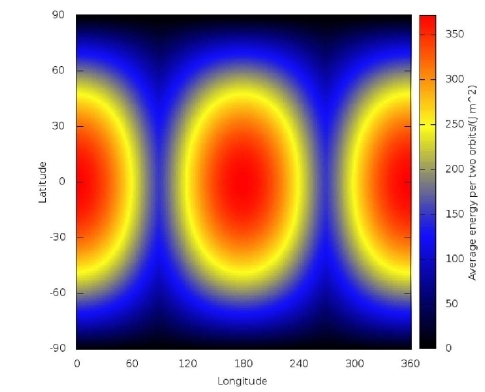
Astonishingly, on such a planet the climate is determined as much by longitude as latitude. Yes, longitude. Some longitudes are in daylight for long periods, while other longitudes never see the sun at all – including a few points on the equator. The planet looks like a tennis ball with burns on opposite sides (red), a temperate zone ringing the burns (yellow), and ice everywhere else (blue). [7]
To be sure, the temperature extremes would be moderated by the atmosphere. My guess is that you would see Hadley cells centered on the hot zones, since the hot air would rise and cold air would come in underneath it. Since the planet rotates so slowly, you wouldn’t see much Coriolis force to shear the atmosphere sideways. So there would probably be steady winds moving toward the center of each hot zone, distributing heat between the zones.
Note, however, that only one “hot” end can face the star at any given moment. The center of each hot zone would face the star continuously for blistering days on end, and then suffer a long night. (I haven’t worked out what the day-night cycle would look like on various points of the planet. Perhaps the temperate zones would be in continuous but relatively soft illumination. For this I need the help of someone who specializes in orbital dynamics.)
In any case, GJ832c would be a nasty planet. It’d have high gravity, temperature extremes, constant wind, and possibly a thick atmosphere and ultraviolet flares from its star. I don’t think you would get large-brained mammals here simply because of the gravity: blood circulation and locomotion would be expensive. Predator actions like leaping and throwing things would be difficult. So would prey defenses like running and climbing.
What would flourish here? Bugs. Bugs are modular, tough, and cheap. They are small enough to be relatively unaffected by gravity, and their chitinous exoskeletons would be relatively impervious to UV flares.
So let’s say that social insect colonies evolve in the temperate zone. But the temperate zone is exceedingly narrow, perhaps just a few hundred miles across. Sooner or later population pressures are going to drive new colonies into the hot and cold zones. There, new colonies could find resources that aren’t in the temperate zone, say particular kinds of hothouse flowers, lichens, and fungi. And they would face new scarcities too, say of water.
On GJ832c, colonies that learned to trade resources across zones would have an enormous survival advantage. Water for nectar, nectar for fungus, and so on. Insects on Earth have signaling mechanisms that could be adapted to manage such trades. For example, they engage in territorial displays in which soldiers posture at the borders between colonies, inflating their limbs to seem more threatening, while “head-counting” ants on each side carry information about the enemy back to the nest. (They probably don’t actually count the soldiers using numerals; more likely they sense the rate of encounters with them.) [8] Such signaling mechanisms could be adapted to convey information for economic exchanges. Colonial brains would store such information, remembering who traded what and for how much. Over many generations, such signaling systems could evolve into language.
You may wonder about tools, since tools have fundamentally shaped the development of language in humans. For brevity’s sake I won’t go into it here, but I’ve worked out how insect colonies could ignite fire, forge metals, and use tools; again, I’ve extrapolated from things social insects do on Earth. With language and tools a species is just a few hops, skips, and jumps away from having a full-fledged civilization.
This doesn’t mean they would think like humans, of course. They would have networks that can support long-term memory, but those networks would have a very different organization and would support very different kinds of physical needs. In the manuscript I discuss the role of simulation and embodied cognition on the development of language.
So, Conclusion B: With the right environmental pressures, social insects could develop long-term memory, language, tool use, and a civilization.
Again, I am not arguing that this is likely, only that it is possible. What do you think? Am I correct in thinking it is possible, or is there something fundamental that I am neglecting?
I’m asking you to put pressure on these ideas. To look for their weak spots. But I would also appreciate it if, for each weak spot, you could suggest a solution, if you can think of one.
Many thanks in advance for your comments and ideas.
——-
Footnotes
1. Seeley, Thomas (2010). Honeybee Democracy, Princeton.
2. Muehlhauser, Luke (2013). Facing The Intelligence Explosion. Machine Intelligence Research Institute. Kindle location 655.
3. Pinker, Steven (2007.) The Language Instinct: How the Mind Creates Language. Harper Perennial, p. 75.
4. Masuko, Keiichi (1986). “Larval hemolymph feeding: a nondestructive parental cannibalism in the primitive ant Amblyopone silvestrii Wheeler (Hymenoptera: Formicidae).” Behav Ecol Sociobiol 19: 249-255. See also http://blog.wildaboutants.com/2010/06/21/question-1-ant-digestion/.
5. Carroll, Sean (2006). Endless Forms Most Beautiful: The New Science of Evo Devo. Norton, p. 176.
6. Planetary Habitability Laboratory data for GJ832c, http://www.hpcf.upr.edu/~abel/phl/hec_plots/hec_orbit/hec_orbit_GJ_832_c.png
7. Brown et al. (2014). “Photosynthetic Potential of Planets in 3:2 Spin Orbit Resonances.” International Journal of Astrobiology 13:4 (279-289). Page 284. I’ve used the figure computed for an eccentricity of 0.2, which I figure is close enough.
8. Hölldobler, B., and Wilson E. O. (2008). The Superorganism: The Beauty, Elegance, and Strangeness of Insect Societies. New York: W. W. Norton, p. 306.

‘Time Delays’ and Exploding Stars
With our focus on nearby stars for both exoplanet detection and SETI work, I don’t often find the time to talk about cosmology and ‘deep sky’ observations, although galaxy structure and formation are an interest of mine. But today I have a story too good to pass up, involving using gravitational lensing and time delays in how light reaches us to investigate events at the edge of the visible universe. In such work, the curvature of spacetime itself is part of our toolkit.
Consider four images found around a foreground galaxy that were created by a background supernova. Here celestial alignments lead us to successful prediction, and for the first time, a supernova appears where astronomers have said it would. Or I should say, ‘re-appears.’
The elliptical galaxy in question is located within the galaxy cluster MACS J1149+2223, which since 2012 has been known to lie between us and a background galaxy whose light is being magnified by the lens of the cluster. In November of 2014, astronomers found four separate images of a supernova from this background galaxy, appearing in the form of a so-called Einstein Cross. Have a look at the image below, where the cross-shaped pattern is clear.
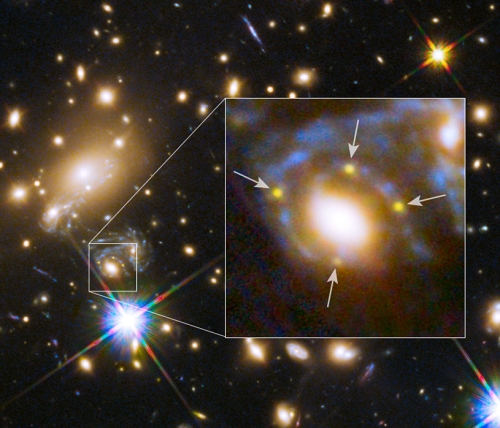
Image: The galaxy cluster MACS J1149+2223. Four images of the same supernova are apparent in the inset image. Credit: NASA, ESA, S. Rodney (John Hopkins University, USA) and the FrontierSN team; T. Treu (University of California Los Angeles, USA), P. Kelly (University of California Berkeley, USA) and the GLASS team; J. Lotz (STScI) and the Frontier Fields team; M. Postman (STScI) and the CLASH team; and Z. Levay (STScI).
Now we have word that on December 11 of this year, a team of astronomers successfully predicted a fifth appearance of the supernova. Of course, the supernova event can occur but once, but we are seeing multiple images whose light has in each case taken a different path to reach us, affected by visible and dark matter in the intervening cluster. This means the images from the background galaxy are somewhat out of synch. A team of astronomers involved in the Grism Lens Amplified Survey from Space (GLASS) and a team from another project called Frontier Fields has been able to model these lensing events with great accuracy.
Tommaso Treu (UCLA) is lead author of one of two papers on this work, which looks at the details of the modeling:
“We used seven different models of the cluster to calculate when and where the supernova was going to appear in the future. It was a huge effort from the community to gather the necessary input data using Hubble, VLT-MUSE, and Keck and to construct the lens models. And remarkably all seven models predicted approximately the same time frame for when the new image of the exploding star would appear.”
The supernova is nicknamed Refsdal, a reference to the Norwegian astronomer Sjur Refsdal, who discussed using time-delayed images from a lensed supernova back in the 1960s. Refsdal believed that such images could be a useful tool for studying the universe’s expansion.
Supernova Refsdal turned up exactly when the astronomers had predicted. Hubble has been at work on MACS J1149 since the end of October, making a series of periodic observations by way of testing the models. The model predicting the supernova’s reappearance was also based on data drawn from the Multi Unit Spectroscopic Explorer (MUSE), attached to ESO’s Very Large Telescope (VLT) at Paranal. This November 25 ESO announcement highlights the prediction, which described the supernova’s brightness as well as its timing and location.
The paper on the supernova’s reappearance points out that despite Refsdal’s early paper, a gravitationally lensed supernova with multiple resolved images was not found in the subsequent five decades (although several individual images have been found with magnification caused by lensing). But astronomers have been able to work on time delays within lensed systems by studying multiply imaged quasars, an effort that has been going on since the 1970s. The ‘reappearance’ paper draws two conclusions about the result of the supernova study:
First, SN Refsdal indeed reappeared approximately as predicted, implying that the unknown systematic uncertainties are not substantially larger than the random uncertainties, at least for some models. This is a remarkable and powerful validation of the model predictions specifically and of general relativity indirectly.
And now that we have a successful prediction, we can start to apply its lessons to the modeling process going forward:
The second conclusion is that already this first detection provides some discriminatory power: not all models fare equally well. Grillo-g, Oguri-g, Oguri-a, and Sharon-a [referring to earlier studies] appear to be the ones that match the observations most closely. In general most models seem to predict a slightly higher magnification ratio than observed, or shorter delays. A detailed statistical analysis of the agreement between the model predictions and the observations will have to wait for the actual measurement of the magnification and time delays, which will require analysis of the full light curve past its peak during 2016.
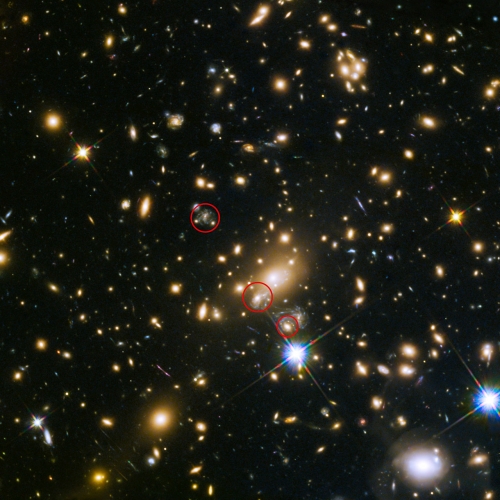
Image: This NASA/ESA Hubble Space Telescope image shows the positions of the past, present and predicted future appearances of the Refsdal supernova behind the galaxy cluster MACS J1149+2223. The uppermost circle shows the position of the supernova as it could have been seen in 1995 (but was not actually observed). The lowermost circle shows the galaxy which lensed the Refsdal Supernova to produce four images — a discovery made in late 2014. The middle circle shows the predicted position of the reappearing supernova in late 2015 or early 2016. Credit: NASA, ESA, S. Rodney (John Hopkins University, USA) and the FrontierSN team; T. Treu (University of California Los Angeles, USA), P. Kelly (University of California Berkeley, USA) and the GLASS team; J. Lotz (STScI) and the Frontier Fields team; M. Postman (STScI) and the CLASH team; and Z. Levay (STScI).
Never before has the appearance of a supernova at a particular time and location in the sky been successfully predicted. We’re now in position to test models involving magnification and time delays for other lensed supernovae. The time delays we see in multiple images of the same event become tools for probing not just the properties of the lensing galaxy and background object, but the properties of cosmic expansion. The fifth image of supernova Refsdal is influenced not only by an individual galaxy but by the gravitational potential of the entire MACS J1149.5+2223 cluster, a reminder of the complexity of the underlying analysis.
The ‘prediction’ paper is Treu et al., “‘Refsdal’ Meets Popper: Comparing Predictions of the Re-appearance of the Multiply Imaged Supernova Behind MACS J1149.5+2223,” in press at The Astrophysical Journal (preprint). The ‘reappearance’ paper is Kelly et al., “Deja Vu All Over Again: The Reappearance of Supernova Refsdal,” submitted to The Astrophysical Journal (preprint).

Looking Ahead to OSIRIS-REx
Back when I was in grade school, we put in several months studying ancient Egyptian culture. I can remember becoming fascinated with the pyramid builders and wanting to immerse myself in the world that produced them. But I don’t think I ever reached the multidisciplinary level of a third-grader named Michael Puzio, who named the asteroid now called Bennu. The sharp-eyed Puzio entered a contest to name the asteroid that the OSIRIS-REx mission will fly to, choosing the Egyptian deity Bennu because he thought the spacecraft resembled the mythological bird.

I call Michael Puzio one smart third-grader, and I’m happy that yesterday’s post, on the near-Earth asteroid 2003 SD220, brought him to mind. The close pass by 2003 SD220 on Christmas Eve prompted a series of radar studies that we’ll now use to help refine its orbit. Bennu is likewise nearby, though at about 500 meters a bit smaller than 2003 SD220, and it too has been the object of study by the planetary radars at Arecibo and Goldstone. We also know that Bennu bears watching as a possible future impactor even if the odds seem slight.
To make sure about those odds, it’s necessary to learn a lot more about objects like Bennu so we can see how tiny factors like the Yarkovsky effect may change its trajectory over time. The latter is determined partly by the shape of the asteroid, whose uneven surface and varied composition result in heat from the Sun being unevenly distributed and emitted. A slight push comes from all this, the smallest of nudges, which over time can add up to the kind of trajectory change that could spell the difference between a close call and something worse.
You can imagine how hard all this would be to calculate, but we need to factor the Yarkovsky effect into any potential asteroid mitigation efforts we may someday have to make. That makes measuring the effect and relating it to accurate mapping of the asteroid’s surface a priority.
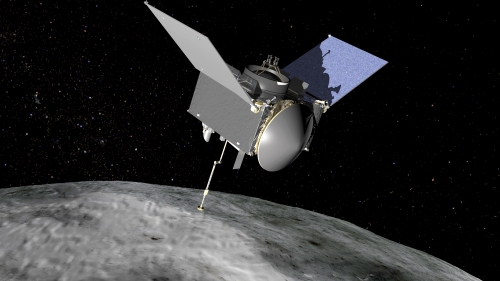
Image: Artist’s conception of the OSIRIS-REx spacecraft during its Touch-and-Go sampling maneuver at Bennu. Credit: NASA/Goddard.
OSIRIS-REx is another of those acronyms that keeps on giving — it stands for Origins Spectral Interpretation Resource Identification Security Regolith Explorer, and pretty much sums up all aspects of the mission that I know about. Launch is planned for September of 2016, with investigation of Bennu by a suite of instruments at the target and a 60-gram sample return. Here we’re trying to learn not only about what such asteroids are made of in case we ever have to nudge one, but also to study materials that may help us understand how water and perhaps organic molecules made their way to the Earth in the early days of the Solar System.
In mid-December, the Canadian Space Agency’s OSIRIS-REx Laser Altimeter (OLA) arrived at Lockheed Martin Space Systems in Denver for integration into the spacecraft. The instrument will produce three-dimensional maps that will help the mission team choose the best site for sample collection. OLA is a LIDAR (Light Detecting and Ranging) system that should tell us much about the asteroid’s topography, surface processes, evolution and overall shape.
Michael Daly (York University, Toronto), instrument lead on OLA, explains its significance (for more, see this OSIRIS-REx news release):
“OLA will measure the shape and topography of Bennu to a much higher fidelity and with much greater efficiency than any planetary science mission has achieved. This information is essential to understanding the evolution and current state of the asteroid. It also provides invaluable information in aid of retrieving a sample of Bennu for return to Earth.”
OSIRIS-REx should reach Bennu in 2018, with sample return scheduled for 2023. The first science data are expected to be returned during an Earth gravity assist in September of 2017. The delivery of OLA complements the July delivery of OVIRS (the OSIRIS-REx Visible and Infrared Spectrometer), which will study spectral signatures from the surface to measure minerals and chemicals at proposed sample sites. All told, five instruments are being integrated into the spacecraft as the system-level environmental testing program proceeds.
It’s all too easy to sensationalize the possibilities of impacts on our planet, but wild-eyed stories in the media don’t negate what common prudence dictates. We must incorporate asteroid mitigation into the rest of our scientific work at near-Earth asteroids. If we never have to use the various technologies that have been discussed for changing an asteroid trajectory, so much the better, but finding out as much as we can about the composition and orbital characteristics of these objects is the sensible way to prepare ourselves for any eventuality. The best insurance is the policy you never have to use.

‘Centaurs’ as Potential Impactors
An asteroid shaped something like a sweet potato swept by the Earth on December 24, though at a sufficient distance (28 times further away than the Moon) to pose no hazard to our planet. 2003 SD220 was making the first of five predicted encounters within the next twelve years, and the measurements made by the planetary radar system at Arecibo on the asteroid’s shape, rotation and other properties will now be useful in refining its orbit. The Jet Propulsion Laboratory’s Goldstone Solar System Radar and the National Radio Astronomy Observatory’s Green Bank Telescope and Very Long Baseline Array also contributed data on the asteroid.
Highly elongated and more than 2 kilometers long, 2003 SD220 is of interest as a possible target for a future space mission, not only because asteroids should give us clues about conditions in the early Solar System, but also because near-Earth asteroids need to be well understood in case we one day find ourselves dealing with a potential impactor.
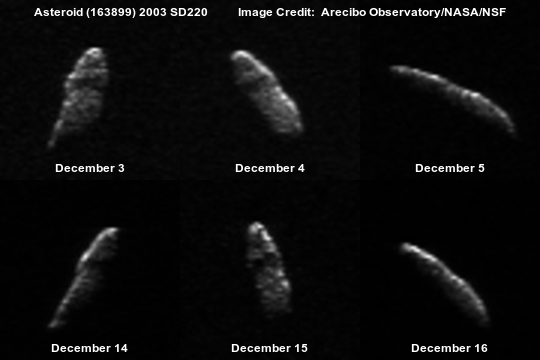
Image: Delay-Doppler image of asteroid 2003 SD220 as observed from the Arecibo Observatory using the NASA-funded planetary radar system on December 3-5 and December 14-15. Credit: Arecibo Observatory.
But as we assess impact probabilities over long periods of time, are asteroids the prime concern? New work out of Armagh Observatory and the University of Buckingham (UK) indicates that we should keep an eye on the outer Solar System, where hundreds of giant comets have been discovered within the last two decades. Known as centaurs, these objects ply unstable orbits that cross the paths of the gas giants. Such encounters can change their trajectories, meaning we need to assess their orbits with care.
The typical centaur is in the 50 to 100 kilometer range — some are larger — with more mass, as this Royal Astronomical Society news release tells us, than the entire population of Earth-crossing asteroids found to date. A centaur deflected onto a trajectory that crosses Earth’s orbit is expected to appear every 40,000 to 100,000 years, according to this work. So while the odds of a direct impact by an intact centaur are slight, these objects are likely to disintegrate as they approach the inner system, with cometary debris posing a potential hazard.
Is cometary dust and debris rather than a single large impact a likely scenario for past extinction events? The paper is currently behind a firewall, but lead author Bill Napier (University of Buckingham) had speculated on the possibility in a paper that appeared earlier this year:
The main asteroid belt seems inadequate to supply the larger impactors, and large cometary populations have now been revealed extending to beyond the planetary system, with the potential to be thrown into the near-Earth environment. The top-heavy mass distribution of these comets, their likely disintegration history when thrown into short-period orbits, and the potential of their debris to cause deleterious effects, make them likely candidates for the mass extinctions observed in the terrestrial record and the associated geological disturbances. The mechanisms involved are a matter for detailed stratigraphic studies; it is suggested here that prolonged atmospheric perturbations arising from fireball storms and dusting are the most energy efficient means of collapsing food chains, yielding both marine and land extinctions.
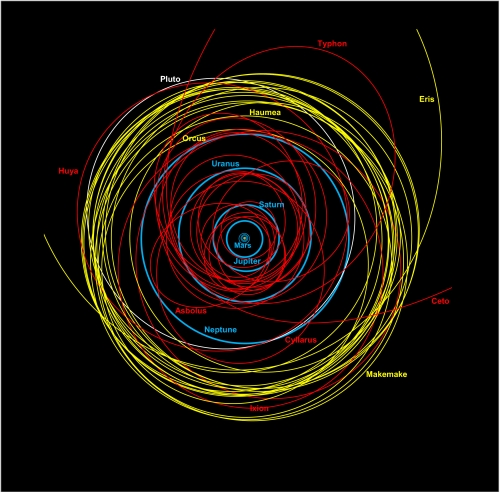
Image: The outer solar system as we now recognise it. At the centre of the map is the Sun, and close to it the tiny orbits of the terrestrial planets (Mercury, Venus, Earth and Mars). Moving outwards and shown in bright blue are the near-circular paths of the giant planets: Jupiter, Saturn, Uranus and Neptune. The orbit of Pluto is shown in white. Staying perpetually beyond Neptune are the trans-Neptunian objects (TNOs), in yellow: seventeen TNO orbits are shown here, with the total discovered population at present being over 1,500. Shown in red are the orbits of 22 Centaurs (out of about 400 known objects), and these are essentially giant comets (most are 50-100 km in size, but some are several hundred km in diameter). Because the Centaurs cross the paths of the major planets, their orbits are unstable: some will eventually be ejected from the solar system, but others will be thrown onto trajectories bringing them inwards. Credit: Duncan Steel.
The image above gives us a sense of how our view of the Solar System has changed over the past century, as we’ve moved from nine planets and an asteroid belt moving through supposedly empty space to a wild jumble of objects including not just asteroids and comets but a vast population of trans-Neptunian objects. You can see how the centaurs cross planetary orbits in the image, and it’s possible that some are captured along the way. Saturn’s moon Phoebe may well have been a centaur that was drawn into Saturn’s gravity well long ago.
Napier puts the new work into perspective:
“In the last three decades we have invested a lot of effort in tracking and analysing the risk of a collision between the Earth and an asteroid. Our work suggests we need to look beyond our immediate neighbourhood too, and look out beyond the orbit of Jupiter to find centaurs. If we are right, then these distant comets could be a serious hazard, and it’s time to understand them better.”
The paper is Napier et al., “Centaurs as a Hazard to Civilization,” Astronomy & Geophysics 56 (6): 6.24-6.30 (abstract). The earlier Napier paper referenced above is “Giant Comets and Mass Extinctions of Life,” Monthly Notices of the Royal Astronomical Society 448 (2015), pp. 27-36 (preprint).

Voyager to a Star
The essay that follows is a much expanded version of a brief post that ran here last April, the idea being to give our Voyager spacecraft one last (symbolic) mission. It will run later this year in a publication called ‘Handbook of the Unknowable,’ produced by Espen Gangvik (Director Trondheim Biennale, Norway) and edited by Rachel Armstrong (Newcastle University, UK) and Rolf Hughes (Stockholm University of the Arts). The book will appear in conjunction with Meta.Morf 2016, a recurring Scandinavian festival dedicated to art and technology, which convenes this year in Trondheim. Armstrong, a familiar figure here on Centauri Dreams, tells me that the Handbook will use its essays, poetry, fiction and art to explore our engagement with space and our future among the stars. Meta.Morf 2016 will take place on March 10-11, and I commend both it and the Handbook to you. More on the event as we get closer. Let me also take this opportunity to wish all my readers the very best for the holidays.
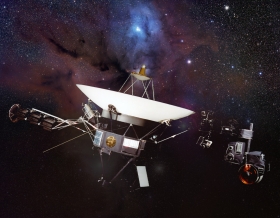
After Voyager 2 flew past Neptune in 1989, much of the world assumed that the story was over, for there were no further planetary encounters possible. But science was not through with the Voyagers then, and it is not through with the Voyagers now. In one sense, they have become a testbed for showing us how long a spacecraft can continue to operate. In a richer sense, they illustrate how an adaptive and curious species can offer future generations the gift of ‘deep time,’ taking its instruments forward into multi-generational missions of interstellar scope.
Now 18.8 billion kilometers from Earth, Voyager 1, which took a much different trajectory than its counterpart by leaving the ecliptic due to its encounter with Saturn’s moon Titan, is 118 times as far from the Sun as the Earth (118 AU). Round trip radio time is over 37 hours. We now believe the craft has left the heliosphere, a ‘bubble’ that is puffed up and shaped by the stream of particles from the Sun called the ‘solar wind.’ Voyager 1 has become our first interstellar spacecraft, and it will keep transmitting until about 2025. Voyager 2, its twin, is currently 109 AU out — 16.4 billion kilometers from the Sun — with a round-trip radio time of over 30 hours.
Throughout history we have filled in the dark places in our knowledge with the products of our imagination, gradually ceding these visions to reality as expeditions crossed oceans and new lands came into view. The Greek historian Plutarch comments that “geographers… crowd into the edges of their maps parts of the world which they do not know about, adding notes in the margin to the effect, that beyond this lies nothing but sandy deserts full of wild beasts, unapproachable bogs, Scythian ice, or a frozen sea…” But deserts get crossed, first by individuals, then by caravans, and frozen seas yield to the explorer with dog-sled and ice-axe.
Voyager and the Long Result
Space is stuffed our imaginings, and despite our telescopes, what we find as we explore continues to surprise us. Voyager showed us unexpected live volcanoes on Jupiter’s moon Io and the billiard ball-smooth surface of Europa, one that seems to conceal an internal ocean. We saw an icy Enceladus, now known to spew geysers, and a smog-shrouded Titan. We found ice volcanoes on Neptune’s moon Triton and a Uranian moon — Miranda — with a geologically tortured surface and a cliff that is the highest known in the Solar System.
But the Voyagers are likewise an encounter with time. The issue raises its head because we are still communicating with spacecraft launched almost forty years ago. I doubt many would have placed a wager on the survival of electronics and internal mechanisms to this point, but these are the very issues raised by our explorations, for we still have trouble pushing any payload up to speeds equalling Voyager 1’s 17.1 kilometers per second. To explore the outer Solar System, and indeed to travel beyond it, is to create journeys measured in decades. With the Voyagers as an example, we may one day learn to harden and upgrade our craft for millennial journeys.
New Horizons took nine years to reach Pluto and its large moon Charon. To reach another star? An unthinkable 70,000 years-plus at Voyager 1 speeds, which is why the propulsion problem looms large as we think about dedicated missions beyond the Solar System. If light itself takes over 18 hours to reach Voyager 1, the nearest star, Proxima Centauri, is a numbing 4.2 light years away. To travel at even a paltry one percent of lightspeed, far beyond our capabilities today, would mean a journey to Proxima Centauri lasting well over four centuries.
What is possible near-term? Ralph McNutt, a veteran aerospace designer at the Johns Hopkins Applied Physics Laboratory, has proposed systems that could take a probe to 1000 AU in less than fifty years, giving us the chance to study the Oort Cloud of comets at what may be its inner edge. Now imagine that system ramped up ten times faster, perhaps boosted by a close pass by the Sun and a coordinated shove from a next-generation engine. Now we can anticipate a probe that could reach the Alpha Centauri stars in about 1400 years. Time begins to curl back on itself — we are talking trip times as great as the distance between the fall of Rome and today.
The interesting star Epsilon Eridani, some 10.5 light years out, would be within our reach in something over three thousand years. Go back that far in human history and you would see Sumerian ziggurats whose star maps faced the sky, as our ancestors confronted the unknown with imagined constellations and traced their destinies through star-based prognostications. The human impulse to explain seems universal, as is the pushing back of frontiers. And if these travel times seem preposterous, they’re worth dwelling on, because they help us see where we are with space technology today, and where we’ll need to be to reach the stars.
A certain humility settles in. While we work to improve propulsion systems, ever mindful that breakthroughs can happen in ways that no one expects, we also have to look at the practicalities of long-haul spaceflight. Both Voyagers have become early test cases in how long a spacecraft can last. They also force us to consider how things last in our own civilization. We have buildings on Earth — the Hagia Sophia in Constantinople, the Pantheon in Rome — that have been maintained for longer than the above Alpha Centauri flight time. A so-called ‘generation ship,’ with crew living and dying aboard the craft, may one day make the journey.
Engagement with deep time is not solely a matter of technology. In the world of business and commerce, our planet boasts abundant examples of companies that have been handed down for centuries within the same family. Construction firm Kongo Gumi, for example, was founded in Osaka in 578, and ended business activity only in 2007, being operated at the end by the 40th generation of the family involved. The Buddhist Shitennoji Temple and many other well known buildings in Japanese history owe much to this ancient firm.
The Japanese experience is instructive. Hoshi Ryokan is an innkeeping company founded in Komatsu in 718 and now operated by the family’s 46th generation. If you’re ever in Komatsu, you can go to a hotel that has been doing business on the site ever since. Nor do we have to stay in Japan. Fonderia Pontificia Marinelli has been making bells in Agnore, Italy since the year 1000, while the firm of Richard de Bas, founded in 1326, continues to make paper in Amvert d’Auvergne, providing its products for the likes of Braque and Picasso.
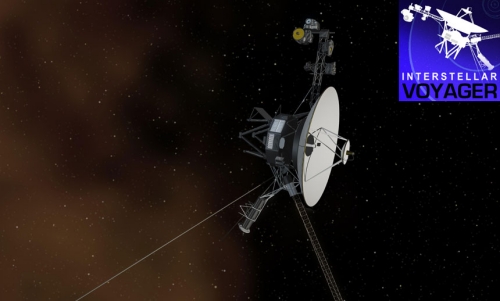
Making Missions that Last
We have long-term thinking in our genes, as the planners of the Pyramids must have assumed. The Long Now Foundation, which studies issues relating to trans-generational thinking and the long-term survival of artifacts, has pointed out that computer code has its own kind of longevity. Enduring like the Sphinx, deeply planted software tools like the Unix kernel may well be operational a thousand years from now. Jon Lomberg and the team behind the One Earth Message — an attempt to transmit a kind of digital ‘Golden Record’ to the New Horizons spacecraft as a catalog of the human condition — estimate that the encoded data will survive at least one hundred thousand years, and perhaps up to a million if given sufficient redundancy.
‘Deep time’ takes us well beyond quarterly stock reports, and even beyond generational boundaries, an odd place to be for a culture that thrives on the slickly fashionable. It’s energizing to know that there is a superstructure that persists. The Voyagers are uniquely capable of keeping this fact in front of us because we see them defying the odds and surviving.
Consider: Only a single instrument on Voyager 1 has broken down since its 1977 launch. Nine other instruments have been powered down on both craft to save critical power resources, but each Voyager has five still-funded experiments and seven that are still delivering data. Stamatios “Tom” Krimigis (JHU/APL) is on record as saying “I suspect it’s going to outlast me.”
Krimigis is one of two principal investigators still on the Voyager mission, out of an original eleven, and the only remaining original member of the Voyager instrument team. His work involves instruments that can measure the flow of charged particles. Such instruments — low-energy charged particle (LECP) detectors — report on the flow of ions, electrons and other charged particles from the solar wind, but because they demanded a 360-degree view, they posed a problem. Voyager had to keep its antenna pointed at the Earth at all times, so the spacecraft couldn’t turn. This meant that the tools needed included an electric motor and a swivel mechanism that could swing back and forth for decades without seizing up in the cold vacuum of space.
The solution was offered by a California company called Schaeffer Magnetics. Krimigis’ team tested the contractor’s four-pound motor, ball bearings and dry lubricant. The company ran the motorized system through half a million ‘steps’ without failure. After more than 5 million steps, the instruments are still working, still detecting a particle flow that is evidently a mix of solar and interstellar particles, one that is moving in a flow perpendicular to the spacecraft’s direction of travel, so that it appears we’re just on the edge of interstellar space, a place where the medium is roiled and frothy, like ocean currents meeting each other and rebounding.
One Last Burn
With the spacecraft now expected to keep transmitting for ten or so more years, we’ll surely see both Voyagers reach true interstellar space before their power runs out. Then the loss of energy will take its toll. Somewhere around 2018 Voyager 1 will shut down its data tape recorder, just as Voyager 2 shuts down its gyros. As instruments go quiet, all power will be shunted to interstellar wind measurements and communications with the distant Earth. As we reach 2020, the few instruments still able to operate by sharing power will be unable to be supported. We’ll be left with only a tracking signal that can last perhaps as late as 2025.
But there is a way to keep the Voyagers alive, if not in equipment then as a part of our lore and our philosophy. They will take about 30,000 years to reach the outer edge of the Oort Cloud (the inner edge, according to current estimates, is maybe 300 years away). Add another 10,000 years and Voyager 1 passes some 100,000 AU past the red dwarf Gliese 445, which happens to be moving toward the Sun and will, by this remote date, be one of the closest stars to the Solar System. As to Voyager 2, it will pass 111,000 AU from Ross 248 in roughly the same time-frame, at which point the red dwarf will actually be the closest star to the Sun.
Carl Sagan and the team working on the Voyager Golden Record wondered whether something could be done about the fact that neither Voyager was headed for another Solar System. Is it possible that toward the end of the Voyagers’ active lifetimes (somewhere in the 2020s), we could set up a trajectory change that would eventually lead Voyager as close as possible to one of these stars? Enough hydrazine is available on each craft that, just before we lose radio contact with them forever, we could give them a final, tank-emptying burn. Tens of thousands of years later, the ancient craft, blind, mute but still more or less intact, would drift in the general vicinity of a star whose inhabitants, if any, might find them and wonder.
A trajectory change would increase only infinitesimally the faint chance that one of these spacecraft would someday be intercepted by another civilization, and neither could return data. But there is something grand in symbolic gestures, magic in the idea that these venerable machines might one day be warmed, however faintly, by the light of another sun. Our spacecraft are our emissaries and the manifestations of our dreams. How we conceive of them through the information they carry helps us gain perspective on ourselves, and shapes the context of our future explorations. Giving the Voyagers one last, hard shove toward a star would speak volumes about our values as a questioning species determined to confront the unknown.
Dawn at Ceres: ‘Down Among Them’
The new images just in from Dawn at Ceres unexpectedly evoke a much earlier mission, the Apollo 10 precursor to the lunar landing. This was the second manned mission to orbit the Moon, one that saw the lunar module drop to just over 15 kilometers from the surface in a rehearsal for the Apollo 11 landing. Just for fun, I’ve been looking through the Apollo 10 transcripts for day 5, when the LM (‘Snoopy’) had already separated from the command module.
John Young was in the command module as Gene Cernan and Tom Stafford put Snoopy through its paces. Nobody had ever been this close to the Moon before. You probably remember or else have read about Snoopy’s descent toward the lunar peaks:
100:25:43 Young: …at 6 miles, he was doing 65 feet a second (20 m/s) on my – 6 miles (9.6 km) from me, he was doing 65 feet per second (20 m/s). At 3.8 miles (6.1 km) he was doing 73 feet per second (22 m/s). I think that confirms this burn. They are down there among the rocks…
As Cernan quickly confirmed:
100:26:54 Cernan (in Snoopy): We is Go, and we is down among them, Charlie.
To which capcom Charlie Duke in Houston replied:
100:26:57 Duke: Roger. I hear you weaving your way up the freeway. Can you give me a post-burn report? Over.
And later:
100:44:57 Cernan (in Snoopy): Hey, I tell you, we are low! We are close, babe! This is, like, it! And it really looks pretty smooth down there, surprisingly enough.
Dawn is not a manned mission, but I couldn’t help thinking of those Apollo 10 moments (still vivid in my memory) when I looked at the latest imagery from Ceres. The spacecraft has now descended into its final and lowest orbit at the dwarf planet, which will bring us the highest resolution images we’ll get. Here we are ‘down among them,’ though not nearly as close as Apollo 10 to the Moon. The altitude is approximately 385 kilometers, an altitude that Dawn will maintain for the rest of the mission. The resolution in the image below is 35 meters per pixel.
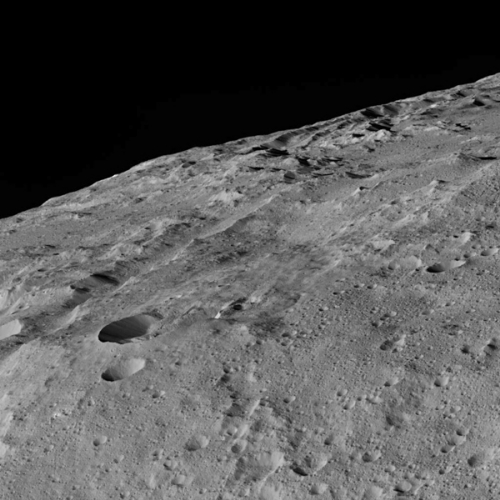
Image: This image of Ceres was taken in Dawn’s low-altitude mapping orbit around a crater chain called Gerber Catena. Credit: NASA/JPL-Caltech/UCLA/MPS/DLR/IDA.
Ceres is a small world, a mere 940 kilometers in diameter, but the trough features are interesting, a common sight on larger planets. They are thought to be the result of impact stresses and contraction, and as this JPL news release points out, may also result from the loading of the crust by large mountains (think Olympus Mons on Mars). Researchers believe similar processes have occurred across Ceres, with some troughs possibly reflecting internal tectonic stresses. “Why they are so prominent is not yet understood,” says Paul Schenk (Lunar and Planetary Institute) but they are probably related to the complex crustal structure of Ceres.”
So bit by bit, we’re working out Ceres’ mysteries. We’ve recently learned that the bright material found in craters like Occator is consistent with hexahydrite, which is a type of magnesium sulfate (see Catching Up with Dawn at Ceres). We’ve also learned that Ceres contains ammoniated clays, which leads to the speculation that it may have formed as far out as the orbit of Neptune and migrated inward, or else later drew in materials that formed there.
We have months of data and imagery ahead. With Dawn’s primary and backup framing cameras both operational, we turn to the craft’s visible and infrared mapping spectrometer, which will identify minerals by analyzing the wavelengths of light reflected off the surface. The abundance of various elements will be measured by the craft’s gamma ray and neutron detector (GRaND). And after operations have ended? Dawn was able to leave Vesta but it will never leave Ceres, its orbit stable enough that it will remain as a satellite of the dwarf planet.
Sometimes I have to remind myself that what I am looking at is real, given that Ceres has been no more than an blurry speck for most of my life. Spaceflight kicks off the grandest of enthusiasms, infusing us with genuine wonder even when we’re in the most demanding of situations. On that note I return briefly to Apollo 10, at the moment during the LM’s descent when the Earth began to rise and highly trained astronauts gave voice to the moment:
100:25:30 Cernan (in Snoopy): Look at that – look at the Earth! Look at the Earth!
[Very excited comments at seeing Earthrise.]
100:25:33 Stafford (in Snoopy): Oh gee. Look at the Earth, John. Get it, get it.
100:25:42 Stafford (in Snoopy): Oh my God, I can’t believe it! It’s just…
I wouldn’t have been able to find the words either. Here’s the image from Snoopy.
